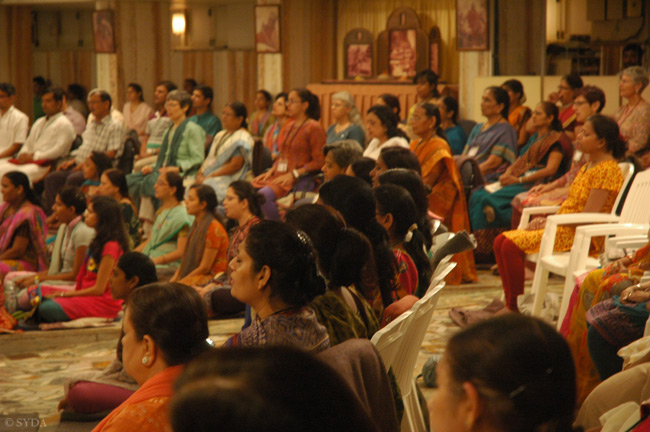Gurumayi then invited Vani to read Baba’s second teaching on guru-tattva in Hindi.
Baba says:
Sṛṣṭi kī racnā ke pehle se hī guru tattva kā astitva thā, aur jal, pṛthvī, vāyu, agni va ākāsh kī hī tarah, yah sṛṣṭi ke ārambh se hī uskā ek bhāg hai. Guru tattva pratyek mẽ uskī antarātmā ke rūp mẽ vidyamān hai. Isliye jab ham guru ke prati apnā sammān prakaṭ karte hãi to ham apnī ātmā kā sammān kar rahe hote hãi. Shri guru ātmā hãi; ve anya ve anya kuch nahī, param citi hãi aur parmānand hãi.
Gurumayi expanded on Baba’s teaching about bliss—ānanda—by beginning the refrain of the abhanga by Tukārām Mahārāj: "Ānandātse Ḍohī."  Everyone immediately joined their grateful voices to Gurumayi’s in singing,
Everyone immediately joined their grateful voices to Gurumayi’s in singing,
Ānandātse ḍohī, ānanda taranga.
Ānadaci anga, ānandātse.
In the great flood of bliss, waves are surging
and they too are nothing but bliss.
for bliss is the nature of every particle of this body of bliss.
Tukārām’s words gave perfect expression to our own experience of the bliss abounding in our hearts.
 After we had sung the abhanga, Gurumayi asked Ami if prema kī nadī—the river of love—was flowing through the Intensive Hall in Gurudev Siddha Peeth.
After we had sung the abhanga, Gurumayi asked Ami if prema kī nadī—the river of love—was flowing through the Intensive Hall in Gurudev Siddha Peeth.
“Yes!” Ami said. Many eyes had welled up with tears. These were rivers of love, Ami said, flowing from each heart and merging with the great ocean of Gurumayi’s love.
Gurumayi then asked Swami Ishwarananda to give a description of the Bhagavan Nityananda Temple in Shree Muktananda Ashram, so that everyone in Gurudev Siddha Peeth could visualize this sacred space. Swami Ishwarananda began, “As you come in the long entrance to the Temple, you see Bade Baba’s teaching inscribed over the archway: ‘The Heart is the hub of all sacred places. Go there and roam.’”
Swamiji added that as you continue walking toward the inner sanctum, you see Baba’s words inscribed above the next archway: ‘I owe my existence to my Shri Guru.’ “These teachings are written in gold,”  Swamiji said. “And then when you cross the threshold, there is the golden form of Bade Baba.”
Swamiji said. “And then when you cross the threshold, there is the golden form of Bade Baba.”
Gurumayi said, “Just like in Gurudev Siddha Peeth.”
Swamiji echoed this statement and then continued to describe the purple robes Bade Baba was wearing and the mauve roses placed around the mūrti and on the silver pādukās. These pādukās have been worshiped for decades, ever since this Temple was first built under Baba’s guidance in 1981, and expanded under Gurumayi’s guidance in 1986.
These pādukās have been worshiped for decades, ever since this Temple was first built under Baba’s guidance in 1981, and expanded under Gurumayi’s guidance in 1986.
Speaking about the roses decorating the Temple, Gurumayi said that their shapes were like the full moon.
Swamiji then spoke about the platform on which Bade Baba is seated. It is made of the whitest marble, and on the front of the platform is an extraordinary etching of the syllable AUM, which was carved by a Siddha Yogi. Swamiji said, “Bade Baba sits on the symbol AUM; he rises from the symbol of AUM. This is his platform—the primordial sound.”
“AUM,” Gurumayi said. “Yes, it is the guru-tattva.”
Swami Ishwarananda then said, “Bhagavan Nityananda arises from the primordial and eternal guru-tattva, AUM.”
Gurumayi requested Swamiji to speak about how much Bade Baba smiles and how many wishes he grants.
Swamiji said, “When you come into the Temple and have Bade Baba’s darshan, you may discover his radiant smile. His smile always carries the rays of benediction. The Temple is a place of abundant grace. So many prayers and wishes are granted by Bade Baba. And if you become very silent and enter your heart, he will speak to you there for sure.”
Gurumayi asked the Gurukula students in Gurudev Siddha Peeth if it was time for bed. Ami responded that everyone was shaking their heads—no! No one wanted the satsang to end.
Gurumayi asked if, in that case, the Gurukula students had anything they wished to say. Hearing Gurumayi’s question, we again experienced the immense generosity with which Gurumayi was giving her devotees the opportunity to be in her presence and offer their love and worship on this auspicious day.
Ami spoke into the microphone, saying that a group of sevites from the Music Department [Arpita Patel, Arati Belsare, Sarika Satibawane, Bhakti Thombare, Ruchi Shukla, Satyarupa Britton, Reena Sonawane, and Jasmina Patel] wished to sing an abhanga: Shri Guru Sārikhā, by the poet-saint, Jnāneshwar Mahārāj.
We would like to take a moment now to explain why the sevites may have chosen this abhanga to sing on Gurupurnima. In 2005 Gurumayi asked the Siddha Yoga meditation teachers to formalize the content of the Celebration Satsangs for seven of the main Siddha Yoga holidays, and to create standard templates for these satsangs that could be used in Siddha Yoga Ashrams and meditation centers around the world. The abhanga Shri Guru Sārikhā, which expresses gratitude for the Guru’s grace and protection, was selected to be part of the Gurupurnima Celebration Satsang.
The sevites sang a cappella:
Shri Guru sārikhā asatā pāthirākhā
Itarāntsā lekhā koṇa karī
My Guru’s protection is always behind me.
With this benediction, what more do I need?